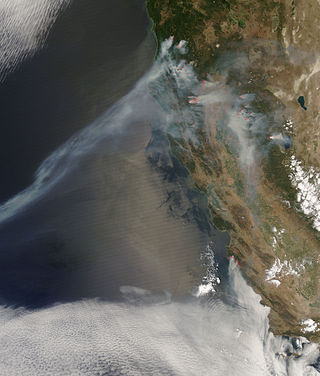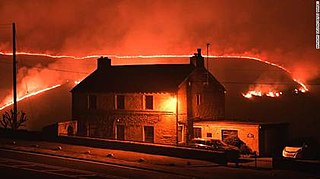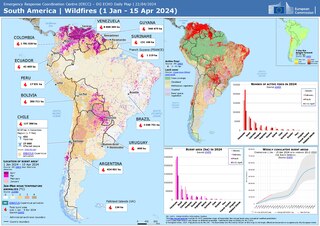Related Research Articles

Ulaanbaatar is the capital and most populous city of Mongolia. It has a population of 1.6 million, and it is the coldest capital city in the world by average yearly temperature. The municipality is located in north central Mongolia at an elevation of about 1,300 metres (4,300 ft) in a valley on the Tuul River. The city was founded in 1639 as a nomadic Buddhist monastic centre, changing location 28 times, and was permanently settled at its modern location in 1778.

Wildfire suppression is a range of firefighting tactics used to suppress wildfires. Firefighting efforts depend on many factors such as the available fuel, the local atmospheric conditions, the features of the terrain, and the size of the wildfire. Because of this wildfire suppression in wild land areas usually requires different techniques, equipment, and training from the more familiar structure fire fighting found in populated areas. Working in conjunction with specially designed aerial firefighting aircraft, fire engines, tools, firefighting foams, fire retardants, and using various firefighting techniques, wildfire-trained crews work to suppress flames, construct fire lines, and extinguish flames and areas of heat in order to protect resources and natural wilderness. Wildfire suppression also addresses the issues of the wildland–urban interface, where populated areas border with wild land areas.

The Zaca Fire was a very large wildfire in the San Rafael Mountains, northeast of the Santa Ynez Valley in Santa Barbara County, California. It was the single largest wildfire of the 2007 California wildfire season. The fire started on July 4, 2007, and by August 31, it had burned over 240,207 acres (972.083 km2), making it California's second largest fire in recorded history at that time after the Cedar Fire of 2003. As of 2024, it is California's 13th-largest recorded fire in modern history. The fire was contained on September 4, 2007, with the fire being brought under control on October 29, 2007.

The 2008 wildfire season was one of California's most devastating in the 21st century. While 6,255 fires occurred, about two-thirds as many as in 2007, the total area burned— 1,593,690 acres —far exceeded that of previous years.

The Ground Force of Mongolia is the land force of the Mongolian Armed Forces, formed from parts of the former Mongolian People's Army in 1992. It was known as the "Mongolian General Purpose Force" until 2016.

Ukhnaagiin Khürelsükh, also referred to as Khürelsükh Ukhnaa, is a Mongolian politician serving as the 6th and current president of Mongolia, beginning his term on 25 June 2021 after winning the 2021 Mongolian presidential election. He was prime minister from October 2017 to January 2021 and was elected to the Parliament of Mongolia four times – in 2000, 2004, 2012 and 2020.

On July 6, 2017, a two-hectare wildfire began west of 100 Mile House, British Columbia, Canada marking the beginning of the record-breaking 2017 wildfire season in British Columbia. On July 7, 56 new fires started throughout British Columbia (BC) leading to several evacuation alerts, orders and the declaration of a provincial state of emergency by the Government of British Columbia. By September 12, 158 fires were burning throughout the province. A total of 12,161 square kilometres had burned by the end of the 2017 fire season, the largest total area burned in a fire season in recorded history. This record was broken the following year, with five of BC's worst 10 fire seasons occurring since 2010. However, the 2017 fire season was also notable for the largest number of total evacuees in a fire season, as well as for the largest single fire ever in British Columbia. Research indicates that human-caused climate change played a significant role in the fires.

By the end of June 2018, there had been more than 560 wildfires in British Columbia.

2019 United Kingdom wildfires were a series of wildfires that began on 26 February 2019 and ended on 18 May 2019. The series of wildfires was considered unusual due to the fact that they took place early in the year. Areas affected by the wildfires in 2019 included those that had already been burnt by wildfires during the summer of 2018. The fires have created many air pollution problems for the UK. The causes of most of the fires have been attributed to much higher than average temperatures and drought conditions that have prevailed since the spring of 2018. There were 137 wildfires larger than 25 hectares (250,000 m2) recorded in the United Kingdom in 2019. This beats the previous record of 79 from 2018.

The 2019 Alberta wildfires have been described by NASA as part of an extreme fire season in the province. In 2019 there were a total of 803,393.32 hectares, which is over 3.5 times more land area burned than in the five-year average burned. The five year average is 747 fires destroying 146,360.08 hectares. There were 644 wildfires recorded in Alberta. By May 31, 10,000 people had been evacuated, 16 homes, and the Steen River CN railway bridge, had been destroyed.

The 2020 Brazil rainforest wildfires were a series of forest fires that were affecting Brazil, with 44,013 outbreaks of fires registered between January and August in the Amazonas and Pantanal. Within the Amazon, 6,315 outbreaks of fire were detected in the same period. Within the Pantanal, the volume of fires is equivalent to those of the past six years and there have been actions by NGOs and volunteers to save endangered animals, such as the jaguar. It was expected that the health systems of the Amazon region, already overloaded by the COVID-19 pandemic, would be even more overloaded due to respiratory diseases due to smoke emitted by the wildfires.

From June 2021, the taiga forests in Siberia and the Far East region of Russia were hit by unprecedented wildfires, following record-breaking heat and drought. For the first time in recorded history, wildfire smoke reached the North Pole.

The 2021 Dixie Fire was an enormous wildfire in Butte, Plumas, Lassen, Shasta, and Tehama counties in Northern California. Named after a nearby Dixie Road, the fire began in the Feather River Canyon near Cresta Dam in Butte County on July 13, 2021, and burned 963,309 acres (389,837 ha) before it was declared 100 percent contained on October 25, 2021. It was the largest single source wildfire in recorded California history, and the second-largest wildfire overall, The fire damaged or destroyed several communities, including Greenville on August 4, Canyondam on August 5, and Warner Valley on August 12.

The 2021 Algeria wildfires were multiple wildfires that happened in the Kabylia region of Algeria since 9 August 2021, which have killed 90 people, including 57 civilians and 33 soldiers. The soldiers died after being trapped in the blaze during rescue operations.

The 2022 Calf Canyon/Hermits Peak Fire was the largest and most destructive wildfire in the history of New Mexico. The fire burned 341,471 acres between early April and late June in the southern Sangre de Cristo Mountains, in San Miguel, Mora, and Taos counties. It was the most significant fire of the record-breaking 2022 New Mexico wildfire season, as well as the largest wildfire of the year in the contiguous United States. The fire destroyed at least 903 structures, including several hundred homes, and damaged 85 more.

The 2024 wildfires in Canada began as an extension of the record-setting 2023 wildfires. The country experienced an unusually long fire season in 2023 that lasted into the autumn; these fires smouldered through the winter and about 150 re-ignited as early as February 2024. By early May, large wildfires had broken out in Alberta, British Columbia, and Manitoba. Soon after, there were significant fires in Saskatchewan, the Northwest Territories, and Newfoundland and Labrador.

The 2024 South American wildfires refer to a mega colossal series of wildfires that significantly impacted several neighboring South American countries, including Bolivia, Brazil, Chile, Colombia, Ecuador, and Peru. Based on Global Wildfire Information System satellite imaging, about 346,112 wildfire hotspots damaged or destroyed 85,866,867 hectares. The massive area burned was primarily caused by anthropogenic climate change and the resulting consequences of the 2023–2024 South American drought on fire conditions. The wildfires caused significant deforestation of the Amazon rainforest, and also impacted several other international biomes including the Pantanal wetlands, becoming the second largest series of wildfires in the 21st century next to the 2023–24 Australian bushfire season, with the 2024 Brazil wildfires alone reaching fourth in area burned.
References
- ↑ Agency, Xinhua News (2022-08-29). "Wildfires ravage Mongolia forests, grassland". The Manila Times. Retrieved 2022-09-01.
- ↑ "Wildfires burn over 1 mln hectares of land in Mongolia so far this year-Xinhua". english.news.cn. Retrieved 2022-09-01.
- ↑ "Mongolian wildfires destroy over 200 thousand hectares - News.MN". News.MN - The source of news. 2020-06-18. Retrieved 2022-09-01.
- ↑ "The number of wildfires in Mongolia rise by 73 percent - News.MN". News.MN - The source of news. 2022-08-29. Retrieved 2022-09-01.